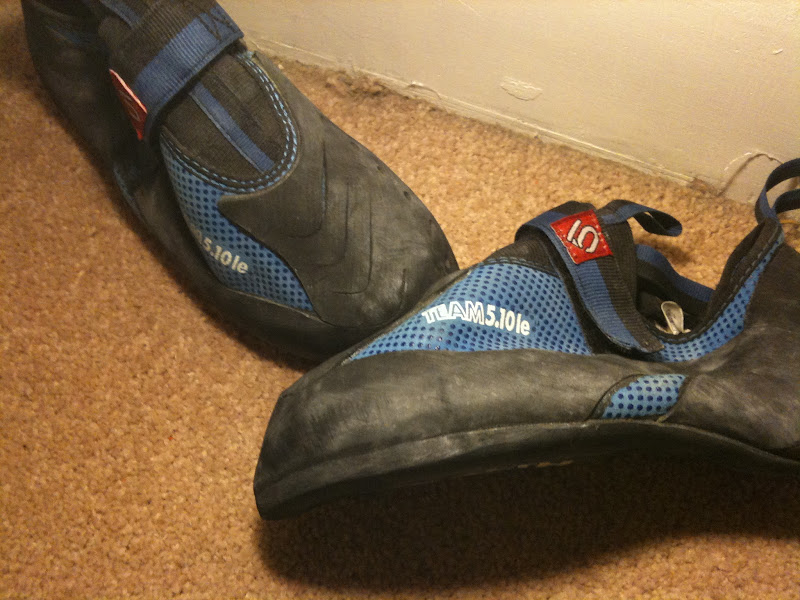Advanced Skills in Climbing
 |
| Breakdown the movement above: left toe turned in, left knee pushed across, pushing out of right leg, locking from right shoulder, reaching left. Advanced or just basic climbing skills? |
I guess it's got me thinking that 'advanced' techniques is really just a culmination of a lot of factors - movement, strength, speed, psychological, etc. As an example see this video (unfortunately no embedding from Dave Graham's website, The Island....) from Rocklands. There's two points that I would consider as advanced:
- the determination and mental strength to give it all even if questioning whether it's do-able, possible, etc
- the point at 3:00 when he jumps for the hold and in the same swing, is able to push his foot into exactly the placement he knew was marked for the next position. His mind is already ahead of the swing that he executes after jumping.
I guess I feel that anything that goes beyond the basic things you (should) learn when you start climbing. If anything many sports are pretty 'basic' in nature - see the ideas of swimming, running, etc - but what I'd regard as 'advanced' is optimizing to perfection (or to the best you possibly can) all of the various components (the start, implementing the power, pacing, etc) that make you faster/better.
The (random, picked out of a pile) photo above of Naomi - is it all basic? (and by this, could you take a relative novice with some instruction/experience) and expect him to replicate this or is it something that has to be developed? All thoughts welcome.....
The other side of it is that learning and teaching this sort of thing is tricky. I was in error/inaccurate in those comments when I said that high performance sports people usually are quite poor coaches. That's not necessarily the case, but a lot of the time it is, and the people who make the best teachers/trainers/coaches are those who have a good standard so that they understand the item they're trying to teach, but not so high that they've forgotten how to explain as it comes so naturally to them. Sharma in the previous post, would be regarded as someone who is exceptional in the sport, but not necessarily the best person for describing/explaining how he's so good.
Anyone thoughts on this? Coaching isn't really common in climbing in Ireland yet so these are questions ahead of the curve (nothing new for me on this blog :) but it's a really interesting topic!

Hats off.
ReplyDeleteIt's interesting to read this as a beginner who is at the receiving end of instruction. There are definitely some people who are much better at teaching than others, and it seems to be a combination of the skill of explaining that you talked about above, and an ability to see what the student is doing or not doing.
ReplyDeleteI spend a certain amount of my time at the wall watching other climbers, especially other women, and trying to work out how all the bits go together, and how to replicate it. This week I was watching Naomi climb problems that I can climb, but she was doing them so much better. I can't always work out what the "better" is. Beyond the physical strength and technique, it's pacing, rhythm, comfort, knowing what to do next - the stuff that makes it look like dancing up a wall.
Looking at the photo of Naomi, yes, I could make that shape with my body. However, would I know that it was the right thing to do there? Possibly not. Would I have the confidence to reach out? Maybe. Would I know what I was going to do next? No. I'm not sure that someone can teach me that, it might be something that only comes with experience. I can be told to slow down and think, but it takes personal "a-ha!" moments for that to become meaningful for me. I've no idea how you teach someone to get their head two moves ahead of their body.
Great reply, Una :) You've hit on the best way to learn already, watch and practice with others (especially when it comes to improving technically)! Even if you don't fully understand what is happening, just by watching, you'll start to make adaptions over time. Then it's a case of practice, practice, practice :)
ReplyDeleteTaking the role of a coach (from a previous life), easiest way to learn how to 'get the head two moves ahead of their body', try to look at every problem you try at the climbing wall for the first time (the location of the holds; the angles of both the wall and the hold - tilted to the side, upside down, etc; the distance between holds) and see if you can work out how to climb it before you pull on. You won't get it right all the time, but with practice (practice practice practice!), it'll start to click and in time you'll find you don't even realize you're doing it. Obviously, doing this with other friends means that you both get to share your info/beta which can also help....... And of course, the extra thing to do is to climb as many different types of rock and different types of problems/routes, it all adds to the knowledge bank :)
Lovely reply, thanks!